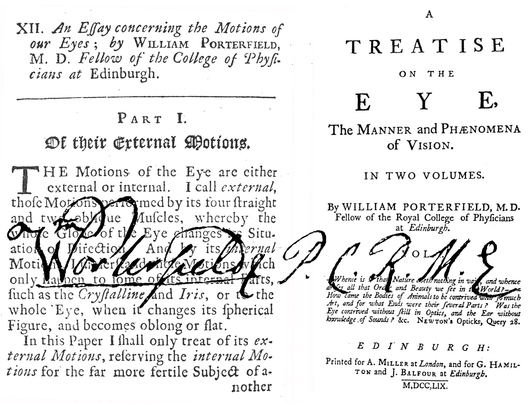William Porterfield1691–1771
It might be expected that someone who had held an esteemed post, like President of the Royal College of Physicians of Edinburgh, would be celebrated in word and image. Such is not the case for Porterfield as little has been written about his life and there is no known portrait of him. He was an active member of the Edinburgh Society for the Improvement of Medical Knowledge, founded in 1731, and he contributed two long articles on eye movements to their journal. In his initial article (in 1737) he described the external movements of the eyes by the actions of the straight and oblique muscles. This essay can be regarded as providing the impetus for more detailed examination of eye movements later in the century. In the second essay (1738) Porterfield discussed the internal movements of the eye – principally those involved in accommodation. He described the first optometer, for measuring the near and far points of vision. Moreover, his studies of an aphakic man (lacking crystalline lenses) who was unable to accommodate established the lenticular basis for accommodation – a term he coined: “That our Eyes change their Conformation, and accommodate themselves to the various Distances of Objects, will be evident to every body, who but reflects on the Manner and most obvious Phænomena of Vision”. Vision was vital to the neuroscience of the day, as estimates of the sizes of nerves derived from measurements of visual acuity. Neither nerve cells nor receptors were known about, and it was assumed that the sizes of nerves serving vision were defined by the minimum spatial resolution. That is, two points were thought to be seen as separate if the light from them fell on neighboring nerves. Porterfield’s estimate of this was one 7200th part of an inch, or around 3.5 microns, which he gave as the estimate of the diameter of nerves. The ideas presented in the two essays provided the foundation for his two volume Treatise which was widely read and remained in use for many years. Porterfield’s agenda was philosophical as well as physiological. He adopted a nativist view of vision and he argued vehemently against empiricist theories such as the one advanced by Berkeley. In the period between writing his essays and his Treatise, Porterfield had a leg amputated; in the first volume of the Treatise he used his experiences of a phantom limb to support the projective features of perception generally. He extended this subjectivity of sensation to phantom limbs, and incorporated the sensations into the body of perceptual theory. His was the first first-hand description of the phenomenon by a medical man. Porterfield remains a shadowy figure in the history of neuroscience although his position in its evolution should be more securely grounded. He was an acute observer and theorist, but these were not matched by his experimental skills. Indeed, his contributions to vision were those of extending theoretically the experiments of his predecessors: he set the scene for others to explore phenomena that he had placed in a more secure theoretical light. In one area he was able to give a unique interpretation of perceptual experience – in the descriptions he provided of sensations apparently arising from his amputated leg. Rather than treating these as illusions, as others had, he incorporated them into the body of the extant neuroscience. This was achieved because of his prior analyses of visual phenomena. Porterfield cannot be portrayed perceptually because he was not portrayed conventionally. We do, however, have an example of his signature, and this is presented together with the title pages of his first article on eye movements and his Treatise.
